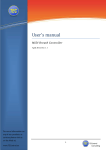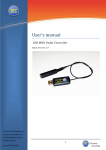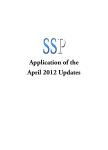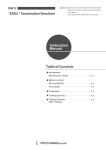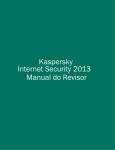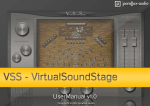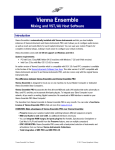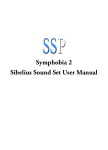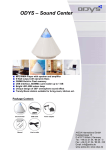Download User's manual
Transcript
User's manual USB MIDI Breath & Bite Controller (BBC) June 2014, Rev 1.0 1 TEControl Consulting The information in this document is subject to change without notice and does not represent a commitment on the part of TEControl. No part of this publication may be copied, reproduced or otherwise transmitted or recorded, for any purpose, without prior written permission by TEControl. All product and company names are ™ or ® trademarks of their respective owners. © TEControl, 2014. All rights reserved. Ragnarsv.2 23192 Trelleborg Sweden For general information about products: [email protected] For technical questions and enquiries: [email protected] For the most up to date information, visit the support pages at our web site http://www.tecontrol.se There you can find documentation and latest software. 2 TEControl Consulting 1 TABLE OF CONTENT Contents 1 Table of content .................................................................................................... 3 2 Revisions ............................................................................................................... 3 3 Introduction .......................................................................................................... 4 4 Overview ............................................................................................................... 5 5 Getting started ...................................................................................................... 6 5.1 Installation .................................................................................................... 6 5.2 Default settings ............................................................................................. 6 5.3 Configuration Utility...................................................................................... 6 5.4 How to program ............................................................................................ 8 6 Compatibility ....................................................................................................... 11 6.1 Sample Libraries .......................................................................................... 11 6.2 Sample players ............................................................................................ 12 7 Control change numbers .................................................................................... 14 8 Declaration of conformity ................................................................................... 19 2 REVISIONS Rev. 1.0 Date 1-June-2014 Major changes First issue 3 TEControl Consulting 3 INTRODUCTION The TEControl team is very happy to be able to serve the community and fill the gap left by Yamaha in the world of breath controllers. We like to think that we took over where Yamaha left, providing the MIDI community with not only a replacement but taking it to a new level corresponding to developments made in the MIDI world during the last couple of years. With sample libraries getting better and better, physical modeling advancing to incredible realism, the need for good controllers is obvious. With the introduction of the USB MIDI Breath & Bite Controller (BBC) we are now able to provide you with dual control: breath controller and in addition bite (lip pressure) controller, the latter until now found only on more expensive wind controllers. To quickly get an overview of the past and present breath and wind controllers, we recommend checking out: http://www.patchmanmusic.com/WindControllerFAQ.html. It contains a very good description of Breath Controllers in general together with available devices. All this said, we encourage suggestions for improvements and new products. The TEControl team 4 TEControl Consulting 4 OVERVIEW The BBC is designed for musicians who want to add extreme expression and realism to their performance. It features two sensors and can be thought of as two independent MIDI controllers which generate continuous MIDI data corresponding to the amount of breath and bite pressures applied. The Breath Controller uses the built-in piezoelectric pressure transducer as input and the Bite Controller uses the integrated bite sensor (located on the lower side of the mouthpiece) to measure the force applied through bite or lip pressure. The Bite Sensor is sensitive to moisture and can be damaged if exposed to excessive humidity. Therefore it is protected by a thin layer of food grade silicone which will prevent any humidity from reaching the sensor. Please, take care not to displace or damage the silicone cover. The mouthpiece bleed adjustment is improved with increased flow and more precise adjustment. The BBC can also send pitch bend and aftertouch. While the aftertouch is straightforward, the pitch bend is due to the nature of the sensors implemented as positive or negative action. We have, however, also included a mode where the full function is available and can be tailored to usability with the sensitivity curve. A unique feature of the BBC is its ability to shape the response from sensor input to MIDI output. It also provides a monitor function simplifying the sensitivity adjustment. This way you can optimize the sensitivity to your own style of playing. The attack and decay filter controls can be set from 0 to several seconds. They allow you to make very smooth swells. With the downloadable Configuration Utility you can configure all the parameters described above as well as save and load your own presets. Signal processing algorithms guarantee full resolution over the configured sensor input ranges. The event-driven MIDI output streaming, filters out redundant data not to overflow your MIDI input and assures lowest latency. MIDI messages are transmitted only when input changes cause a change in the MIDI output value. The BBC does not require installation of drivers or software. It will work with the default settings straight out of the box with both Windows and Mac OS. 5 TEControl Consulting 5 GETTING STARTED 5.1 Installation Connect the BBC to a USB port on your computer, which will detect it automatically and configure the operating system’s built-in USB-MIDI class driver. The BBC will show as “Breath Controller X.Y-ZZZZZZZZ” in your applications, where X.Y is the firmware version and ZZZZZZZZ is the unique serial number. It is fully functional with the default settings. 5.2 Default settings The BBC comes pre-configured with default settings and will work straightout-of-the box. The default settings are as follows: • Linear sensitivity • Input and output ranges set to maximum • Attack and decay filters disabled • MIDI channel 1 • MIDI Message set to Control Change • CC# 2 [breath control] and CC#1 [modulation wheel] To change the settings, download version 3.0 or later of the Breath Controller Configuration Utility from www.tecontrol.se, unzip it and run the installer. For future enhancements, firmware upgrades may be made available. 5.3 Configuration Utility When started, the Configuration Utility will check for a connected Breath Controller. If not found, the lower portion of the window will display an error message "Error: controller not found. Please check "Select Controller" under the File Menu". This message could indicate that it is the first time you use your BBC or that there is no BBC connected to your computer. First time use; In the menu "File/Select controller", select the correct device. It has been reported to us that on some Windows installations, the operating system may report the Breath Controller as "USB Audio Device" instead of "Breath Controller X.Y-ZZZZZZZZ". For those rare instances, please use "File->Select controller" to select the correct device. 6 TEControl Consulting 1 2 3 4 Figure 1 - Default settings 1 The left part of the window shows the sensitivity curves of both sensors simultaneously. 2 The two controllers are configured independently and are selected by clicking the respective tab located on the right side of the window. 3 The Configuration Utility includes the possibilities to Save and Load as many presets as you like. This is very convenient since each sample library, VST instrument or keyboard/synthesizer might require different settings. The Save preset button lets you save the settings of both sensors to a file location and file name of your choice. The filename extension ".tec" is added by default. Here you can also enable/disable the sensor input monitor function. 4 Located at the bottom of the window is a message window which reports the response of your actions as well as potential error messages. Please, keep an eye on the messages displayed there to detect any problems. 7 TEControl Consulting In your DAW, player etc... the BBC must be selected as a MIDI input device in order to work. The BBC also appears in the list of MIDI output devices but should NOT be selected since it is used by the Configuration Utility. In your DAW, you must also configure the MIDI input of the track you are playing or recording to "MIDI omni", "All MIDI inputs" or similar function that configures the track to responds to all MIDI controllers. This is necessary to allow you to control the instrument from both keyboard and BBC. WARNING!!! Due to the nature of the BBC (or any other MIDI controller) the CC will be left at zero value when you release the pressure (i.e. stop blowing or biting). Depending on the CC you are controlling you might not hear any sound without blowing. You might get into a deadlock if e.g. you first use the BBC with CC 7 (volume), stop blowing will leave your instrument volume at zero value, change the CC to e.g. 11 (expression). No sound will be heard since the CC 7 - volume is still at zero. Please, keep this in mind before contacting support. To solve the problem either restart your sample player or try the following: • • • Select the CC that might be left at zero. While applying pressure change the CC to e.g. 1 (mod wheel) Repeat if you have more CCs left at zero 5.4 How to program The 8 sliders of the Configuration Utility let you tailor the response from input pressure to MIDI CC value. Select sensor by clicking the appropriate tab located above the sliders. With the Bending and Symmetry sliders you can change the linear response to various shapes. The Input Min sets the threshold of the input pressure i.e. any pressure below the threshold will not cause any change in the output CC value. The Input Max can be tailored to how hard you want to blow to achieve max CC value (set by Output Max). 8 TEControl Consulting With the Output Min you can set the output CC value to be used for pressures below the input threshold. This is useful if you don't want the CC value to drop to zero. The Output Max sets the maximum CC value to be sent. The Reset sensitivity button resets the sensitivity to linear with full input and output ranges. Figure 2 - Sensitivity settings With the MIDI Channel drop-down list you set the MIDI channel to be used for the transmission of the MIDI message. The MIDI CC drop-down list lets you select the actual controller to be used e.g. CC1 [Modulation Wheel], CC2 [Breath Control] etc... See annex for a complete list. The MIDI CC is effective only when Control Change is selected in the MIDI Message drop-down list. 9 TEControl Consulting In the MIDI Message drop-down list you can in addition to the above mentioned Control Change also select Aftertouch, Pitch Bend Up, Pitch Bend Down and Pitch Bend Both. Note that when either Aftertouch or any of the Pitch Bend options are selected the MIDI CC drop down is grayed out. Aftertouch is what the MIDI specification refers to as channel pressure. Due to the nature of the sensors used, Pitch Bend can only be used in one direction; Pitch Bend Up or Pitch Bend Down. We have, however, also included a Pitch Bend Both mode, where the full function is available and can be tailored to usability with the sensitivity curve. The Attack Filter and Decay Filter sliders let you set the respective time constants individually. Setting the sliders fully left give you the fastest response (filter disabled) and setting them fully right allows time constants of several seconds. This is very useful for semi-automatic swells. All the above changes to the settings take immediate effect but are lost when the computer is powered off or the BBC is removed from the computer. To store you settings permanently in the BBC, use the Make permanent button. This means your settings are remembered when the Breath controller is unpowered. You can now move it to another host with your favorite settings intact. Every time you use the Make permanent button the Configuration Utility stores the parameters in your computer’s registry as well and automatically retrieves them when you restart the Configuration Utility, even if the controller is not connected. The Configuration Utility includes an input monitor function for both sensors, where a dot is travelling along the sensitivity and curve indicates the sensor input. The monitor is controlled by the Enable Monitor/Disable Monitor button. In the MAC version you can play your keyboard while you monitor the breath input. Due to limitations in Windows this is unfortunately not possible and therefore you have to disable the Breath Controller in your sequencer. 10 TEControl Consulting Figure 3 - Monitoring function 6 COMPATIBILITY 6.1 Sample Libraries Compatibility has been verified with the following sample libraries: 8DIO - Adagio violas. Beautiful, beautiful! AudioBro LA Scoring Strings LASS - Excellent results can be achieved by controlling the Kontakt player ModWheel or Expression with MIDI Breath Controller CC data. East West Quantum Leap (EWQL) - East West Play Software is easily controlled by the BBC by using e.g. ModWheel or Expression CC data. 11 TEControl Consulting Orchestration Tools. We have tested the Berlin Woodwinds and it works fantastically well. ProjectSam - Both Symphobia 1 & 2 and True Strike 1 & 2 use the Kontakt player and works beautifully with the MIDI Breath Controller. Samplemodeling - We have tested the Trumpet (Kontakt based) and the Clarinet (SWAM based). It's a marriage made in heaven! SpectraSonics - The MIDI Breath Controller works great with Omnisphere, Trilian and Stylus RMX. Spitfire Albion - This library uses the Kontakt player from Native Instrument and is easily controlled from the MIDI Breath Controller through ModWheel or Expression CC data. Vienna Symphonic Library (VSL) - The Vienna Instrument PRO has itself extensive capabilities of routing any CC data to appropriate parameters as well as a fully configurable sensitivity curve. The MIDI Breath Controller works wonderfully with e.g EPIC horns. Wallander Instruments - A perfect match! All their instruments sounds incredible and are easily controlled with the Breath Controller. 6.2 Sample players EastWest's Play engine Kontakt player from Native Instruments Vienna Instrument Pro from VSL As we are continuing expanding this list, please, refer to our website for the latest updates. We have not found any sample player incompatible with the BBC. There are of course many left to be tested and although TEControl cannot guarantee compatibility there is no reason to believe the BBC isn't compatible with all of them assuming they all comply with the MIDI standards. Concerning direct 12 TEControl Consulting connection of the BBC to a keyboard/synthesizer, please, refer to our website for latest compatibility updates. 13 TEControl Consulting 7 CONTROL CHANGE NUMBERS The following table lists all currently defined Control Change messages and Channel Mode messages, in control number order. (Adopted from "MIDI by the Numbers" by D. Valenti-Electronic Musician 2/88, updated by the MIDI Manufacturers Association.) Registered Parameter Numbers (RPNs) are an extension to the Control Change message for setting additional parameters. Appended at the bottom is a table of all currently defined RPNs. Control Changes and Mode Changes (Status Bytes 176-191) Control Number (2nd Byte Value) Dec Binary 3rd Byte Value Control Function Hex Value Used As 0 00000000 00 Bank Select 0-127 MSB 1 00000001 01 Modulation Wheel or Lever 0-127 MSB 2 00000010 02 Breath Controller 0-127 MSB 3 00000011 03 Undefined 0-127 MSB 4 00000100 04 Foot Controller 0-127 MSB 5 00000101 05 Portamento Time 0-127 MSB 6 00000110 06 Data Entry MSB 0-127 MSB 7 00000111 07 Channel Volume (formerly Main Volume) 0-127 MSB 8 00001000 08 Balance 0-127 MSB 9 00001001 09 Undefined 0-127 MSB 10 00001010 0A Pan 0-127 MSB 11 00001011 0B Expression Controller 0-127 MSB 12 00001100 0C Effect Control 1 0-127 MSB 13 00001101 0D Effect Control 2 0-127 MSB 14 00001110 0E Undefined 0-127 MSB 15 00001111 0F Undefined 0-127 MSB 16 00010000 10 General Purpose Controller 1 0-127 MSB 17 00010001 11 General Purpose Controller 2 0-127 MSB 14 TEControl Consulting 18 00010010 12 General Purpose Controller 3 0-127 MSB 19 00010011 13 General Purpose Controller 4 0-127 MSB 20 00010100 14 Undefined 0-127 MSB 21 00010101 15 Undefined 0-127 MSB 22 00010110 16 Undefined 0-127 MSB 23 00010111 17 Undefined 0-127 MSB 24 00011000 18 Undefined 0-127 MSB 25 00011001 19 Undefined 0-127 MSB 26 00011010 1A Undefined 0-127 MSB 27 00011011 1B Undefined 0-127 MSB 28 00011100 1C Undefined 0-127 MSB 29 00011101 1D Undefined 0-127 MSB 30 00011110 1E Undefined 0-127 MSB 31 00011111 1F Undefined 0-127 MSB 32 00100000 20 LSB for Control 0 (Bank Select) 0-127 LSB 33 00100001 21 LSB for Control 1 (Modulation Wheel or Lever) 0-127 LSB 34 00100010 22 LSB for Control 2 (Breath Controller) 0-127 LSB 35 00100011 23 LSB for Control 3 (Undefined) 0-127 LSB 36 00100100 24 LSB for Control 4 (Foot Controller) 0-127 LSB 37 00100101 25 LSB for Control 5 (Portamento Time) 0-127 LSB 38 00100110 26 LSB for Control 6 (Data Entry) 0-127 LSB 39 00100111 27 LSB for Control 7 (Channel Volume, formerly Main Volume) 0-127 LSB 40 00101000 28 LSB for Control 8 (Balance) 0-127 LSB 41 00101001 29 LSB for Control 9 (Undefined) 0-127 LSB 42 00101010 2A LSB for Control 10 (Pan) 0-127 LSB 43 00101011 2B LSB for Control 11 (Expression Controller) 0-127 LSB 44 00101100 2C LSB for Control 12 (Effect control 1) 0-127 LSB 45 00101101 2D LSB for Control 13 (Effect control 2) 0-127 LSB 46 00101110 2E LSB for Control 14 (Undefined) 0-127 LSB 47 00101111 2F LSB for Control 15 (Undefined) 0-127 LSB 48 00110000 30 LSB for Control 16 (General Purpose Controller 1) 0-127 LSB 49 00110001 31 LSB for Control 17 (General Purpose Controller 2) 0-127 LSB 50 00110010 32 LSB for Control 18 (General Purpose Controller 3) 0-127 LSB 51 00110011 33 LSB for Control 19 (General Purpose Controller 4) 0-127 LSB 15 TEControl Consulting 52 00110100 34 LSB for Control 20 (Undefined) 0-127 LSB 53 00110101 35 LSB for Control 21 (Undefined) 0-127 LSB 54 00110110 36 LSB for Control 22 (Undefined) 0-127 LSB 55 00110111 37 LSB for Control 23 (Undefined) 0-127 LSB 56 00111000 38 LSB for Control 24 (Undefined) 0-127 LSB 57 00111001 39 LSB for Control 25 (Undefined) 0-127 LSB 58 00111010 3A LSB for Control 26 (Undefined) 0-127 LSB 59 00111011 3B LSB for Control 27 (Undefined) 0-127 LSB 60 00111100 3C LSB for Control 28 (Undefined) 0-127 LSB 61 00111101 3D LSB for Control 29 (Undefined) 0-127 LSB 62 00111110 3E LSB for Control 30 (Undefined) 0-127 LSB 63 00111111 3F LSB for Control 31 (Undefined) 0-127 LSB 64 01000000 40 Damper Pedal on/off (Sustain) ≤63 off, ≥64 on --- 65 01000001 41 Portamento On/Off ≤63 off, ≥64 on --- 66 01000010 42 Sostenuto On/Off ≤63 off, ≥64 on --- 67 01000011 43 Soft Pedal On/Off ≤63 off, ≥64 on --- 68 01000100 44 Legato Footswitch ≤63 Normal, ≥64 Legato --- 69 01000101 45 Hold 2 ≤63 off, ≥64 on --- 70 01000110 46 Sound Controller 1 (default: Sound Variation) 0-127 LSB 71 01000111 47 Sound Controller 2 (default: Timbre/Harmonic Intens.) 0-127 LSB 72 01001000 48 Sound Controller 3 (default: Release Time) 0-127 LSB 73 01001001 49 Sound Controller 4 (default: Attack Time) 0-127 LSB 74 01001010 4A Sound Controller 5 (default: Brightness) 0-127 LSB 75 01001011 4B Sound Controller 6 (default: Decay Time - see MMA RP021) 0-127 LSB 76 01001100 4C Sound Controller 7 (default: Vibrato Rate - see MMA RP-021) 0-127 LSB 77 01001101 4D Sound Controller 8 (default: Vibrato Depth - see MMA RP-021) 0-127 LSB 78 01001110 4E Sound Controller 9 (default: Vibrato Delay - see MMA RP-021) 0-127 LSB 79 01001111 4F Sound Controller 10 (default undefined - see MMA RP021) 0-127 LSB 16 TEControl Consulting 80 01010000 50 General Purpose Controller 5 0-127 LSB 81 01010001 51 General Purpose Controller 6 0-127 LSB 82 01010010 52 General Purpose Controller 7 0-127 LSB 83 01010011 53 General Purpose Controller 8 0-127 LSB 84 01010100 54 Portamento Control 0-127 LSB 85 01010101 55 Undefined --- --- 86 01010110 56 Undefined --- --- 87 01010111 57 Undefined --- --- 88 01011000 58 High Resolution Velocity Prefix 0-127 LSB 89 01011001 59 Undefined --- --- 90 01011010 5A Undefined --- --- 91 01011011 5B Effects 1 Depth (default: Reverb Send Level - see MMA RP-023) (formerly External Effects Depth) 0-127 --- 92 01011100 5C Effects 2 Depth (formerly Tremolo Depth) 0-127 --- 93 01011101 5D Effects 3 Depth (default: Chorus Send Level - see MMA RP-023) (formerly Chorus Depth) 0-127 --- 94 01011110 5E Effects 4 Depth (formerly Celeste [Detune] Depth) 0-127 --- 95 01011111 5F Effects 5 Depth (formerly Phaser Depth) 0-127 --- 96 01100000 60 Data Increment (Data Entry +1) (see MMA RP-018) N/A --- 97 01100001 61 Data Decrement (Data Entry -1) (see MMA RP-018) N/A --- 98 01100010 62 Non-Registered Parameter Number (NRPN) - LSB 0-127 LSB 99 01100011 63 Non-Registered Parameter Number (NRPN) - MSB 0-127 MSB 100 01100100 64 Registered Parameter Number (RPN) - LSB* 0-127 LSB 101 01100101 65 Registered Parameter Number (RPN) - MSB* 0-127 MSB 102 01100110 66 Undefined --- --- 103 01100111 67 Undefined --- --- 104 01101000 68 Undefined --- --- 105 01101001 69 Undefined --- --- 106 01101010 6A Undefined --- --- 107 01101011 6B Undefined --- --- 108 01101100 6C Undefined --- --- 109 01101101 6D Undefined --- --- 110 01101110 6E Undefined --- --- 111 01101111 6F Undefined --- --- 17 TEControl Consulting 112 01110000 70 Undefined --- --- 113 01110001 71 Undefined --- --- 114 01110010 72 Undefined --- --- 115 01110011 73 Undefined --- --- 116 01110100 74 Undefined --- --- 117 01110101 75 Undefined --- --- 118 01110110 76 Undefined --- --- 119 01110111 77 Undefined --- --- Note: Controller numbers 120-127 are reserved for Channel Mode Messages, which rather than controlling sound parameters, affect the channel's operating mode. (See also Table 1.) 120 01111000 78 [Channel Mode Message] All Sound Off 0 --- 121 01111001 79 [Channel Mode Message] Reset All Controllers (See MMA RP-015) 0 --- 122 01111010 7A [Channel Mode Message] Local Control On/Off 0 off, 127 on --- 123 01111011 7B [Channel Mode Message] All Notes Off 0 --- 124 01111100 7C [Channel Mode Message] Omni Mode Off (+ all notes off) 0 --- 125 01111101 7D [Channel Mode Message] Omni Mode On (+ all notes off) 0 --- --- --- 126 01111110 7E [Channel Mode Message] Mono Mode On (+ poly off, + all notes off) Note: This equals the number of channels, or zero if the number of channels equals the number of voices in the receiver. 127 01111111 7F [Channel Mode Message] Poly Mode On (+ mono off, +all notes off) 0 18 TEControl Consulting 8 DECLARATION OF CONFORMITY 19 TEControl Consulting 20 TEControl Consulting





















